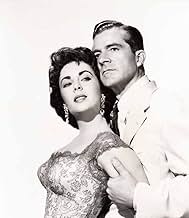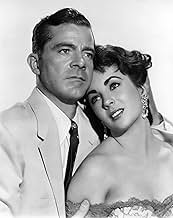AVALIAÇÃO DA IMDb
6,3/10
2,8 mil
SUA AVALIAÇÃO
Adicionar um enredo no seu idiomaThe young bride of a rich planter finds herself the only white woman at Elephant Walk tea plantation, British Ceylon.The young bride of a rich planter finds herself the only white woman at Elephant Walk tea plantation, British Ceylon.The young bride of a rich planter finds herself the only white woman at Elephant Walk tea plantation, British Ceylon.
My Lee Haulani
- Rayna
- (as Mylee Haulani)
Henry Carr
- Servant
- (não creditado)
Delmar Costello
- Native Patient
- (não creditado)
Jiva Raj De Alwis
- Servant
- (não creditado)
Charles Heard
- Planter
- (não creditado)
- Direção
- Roteiristas
- Elenco e equipe completos
- Produção, bilheteria e muito mais no IMDbPro
Enredo
Você sabia?
- CuriosidadesVivien Leigh was originally cast as Ruth. Her mental illness began affecting things during filming, and she was replaced by Dame Elizabeth Taylor. Many long shots and shots from behind are still of Leigh.
- Erros de gravaçãoDuring the first bicycle polo scene, there are four drink glasses on the server's tray when John Wiley takes one, followed by another rider who also grabs a glass, leaving just two on the tray. However the very next pass in which a rider goes for a glass the tray is full.
- Citações
Ruth Wiley: Oh, what a beautiful view!
John Wiley: That's the elephant walk where the place got its name. Before the governor built here, the elephants used to come down that track for centuries to get to the water.
Ruth Wiley: They don't still try to come through do they?
John Wiley: Elephants always remember.
- ConexõesFeatured in Edith Head: The Paramount Years (2002)
Avaliação em destaque
The story is set in the years immediately after the end of World War II. John Wiley, a tea planter from Ceylon, as Sri Lanka was then called, meets a young woman named Ruth on visit England. The two fall in love, marry and move back to John's plantation, Elephant Walk, so named because it was built across a migration route used by a local herd of wild elephants to get to water. The elephants, in fact, still try to use the route, and have to be kept out by a wall or frightened away by occasional gunshots.
Ruth and John face several problems in their marriage. She feels lonely because she is the only white woman in the district. John's elderly Ceylonese servant Appuhamy takes a dislike to her, which matters because John often takes the experienced older man's advice. She in turn takes a dislike a group of white men, all of them bachelors, who regularly call at John's bungalow where their main occupations are getting drunk and playing rowdy games of indoor bicycle polo. (In Britain itself, the word "bungalow" has come to mean a modest single-storey dwelling, but in colonial usage it could also be used to mean a plantation owner's mansion, which might have two storeys, as John's indeed does). John calls these men his friends, but Ruth believes that they are parasites who are exploiting his hospitality for the sake of the alcohol he gives them.
Worst of all, John refuses to countenance any changes in the running of the plantation; he is dominated by the memory of his late father Tom, who died several years earlier, and believes that everything must be done as it was in the old man's day. Tom's study is preserved as a shrine which Ruth is forbidden to enter. Ruth feels that she is falling out of love with John, and finds herself attracted to his American manager Dick Carver.
The original intention was to have the roles of John and Ruth played by Laurence Olivier and Vivien Leigh, who were of course husband and wife in real life. Olivier was committed to other projects, but Leigh was cast opposite Peter Finch. She began filming in on location in Ceylon but had to withdraw for health reasons, being replaced by Elizabeth Taylor. I cannot help thinking that the film would have been very different had it been completed with Leigh. Finch was sixteen years older than Taylor, and the film that we have is in many ways a standard older man/younger woman romance of the sort that was so popular in the fifties. Leigh, however, was actually four years older than Finch, and had Ruth been played as a middle-aged woman rather than a young girl the relationship between the two main characters would have been altered.
There are obvious similarities between "Elephant Walk" and the Charlton Heston/Eleanor Parker vehicle "The Naked Jungle", also from 1954. Both films have at their centre a plantation owner who marries a wife who finds it difficult to fit into plantation life, leading to tensions in their marriage. (In "The Naked Jungle" the main character is American and owns a rubber plantation in South America). In both films the plantation is threatened by a seemingly unstoppable force of nature, the elephants here and an army of ants in the other movie. And the two films are similar in terms of quality. In neither case is the film its stars' greatest triumph; Heston and Parker made many films that were better than "The Naked Jungle", just as Finch and Taylor appeared in many better than this one. This does not mean, however, that either film is a bad one. Like "The Naked Jungle", "Elephant Walk" was popular with audiences in its day, and continues to be watchable today, at least by anyone with a taste for fifties melodrama. 6/10.
Ruth and John face several problems in their marriage. She feels lonely because she is the only white woman in the district. John's elderly Ceylonese servant Appuhamy takes a dislike to her, which matters because John often takes the experienced older man's advice. She in turn takes a dislike a group of white men, all of them bachelors, who regularly call at John's bungalow where their main occupations are getting drunk and playing rowdy games of indoor bicycle polo. (In Britain itself, the word "bungalow" has come to mean a modest single-storey dwelling, but in colonial usage it could also be used to mean a plantation owner's mansion, which might have two storeys, as John's indeed does). John calls these men his friends, but Ruth believes that they are parasites who are exploiting his hospitality for the sake of the alcohol he gives them.
Worst of all, John refuses to countenance any changes in the running of the plantation; he is dominated by the memory of his late father Tom, who died several years earlier, and believes that everything must be done as it was in the old man's day. Tom's study is preserved as a shrine which Ruth is forbidden to enter. Ruth feels that she is falling out of love with John, and finds herself attracted to his American manager Dick Carver.
The original intention was to have the roles of John and Ruth played by Laurence Olivier and Vivien Leigh, who were of course husband and wife in real life. Olivier was committed to other projects, but Leigh was cast opposite Peter Finch. She began filming in on location in Ceylon but had to withdraw for health reasons, being replaced by Elizabeth Taylor. I cannot help thinking that the film would have been very different had it been completed with Leigh. Finch was sixteen years older than Taylor, and the film that we have is in many ways a standard older man/younger woman romance of the sort that was so popular in the fifties. Leigh, however, was actually four years older than Finch, and had Ruth been played as a middle-aged woman rather than a young girl the relationship between the two main characters would have been altered.
There are obvious similarities between "Elephant Walk" and the Charlton Heston/Eleanor Parker vehicle "The Naked Jungle", also from 1954. Both films have at their centre a plantation owner who marries a wife who finds it difficult to fit into plantation life, leading to tensions in their marriage. (In "The Naked Jungle" the main character is American and owns a rubber plantation in South America). In both films the plantation is threatened by a seemingly unstoppable force of nature, the elephants here and an army of ants in the other movie. And the two films are similar in terms of quality. In neither case is the film its stars' greatest triumph; Heston and Parker made many films that were better than "The Naked Jungle", just as Finch and Taylor appeared in many better than this one. This does not mean, however, that either film is a bad one. Like "The Naked Jungle", "Elephant Walk" was popular with audiences in its day, and continues to be watchable today, at least by anyone with a taste for fifties melodrama. 6/10.
- JamesHitchcock
- 13 de jun. de 2022
- Link permanente
Principais escolhas
Faça login para avaliar e ver a lista de recomendações personalizadas
- How long is Elephant Walk?Fornecido pela Alexa
Detalhes
Bilheteria
- Orçamento
- US$ 3.000.000 (estimativa)
- Faturamento bruto mundial
- US$ 143
- Tempo de duração1 hora 43 minutos
- Cor
- Proporção
- 1.37 : 1
Contribua para esta página
Sugerir uma alteração ou adicionar conteúdo ausente

Principal brecha
By what name was No Caminho dos Elefantes (1954) officially released in India in English?
Responda






























